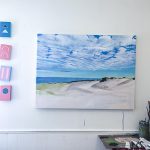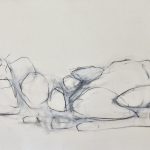STORY BY HOLLY WREN SPAULDING
Photos Courtesy of The Provincial
We must give you fair warning: Upon reading this article, you are likely to find yourself checking directions to the tiny village in Michigan where Melanie Parke’s The Provincial resides. As in her other MADE columns, Holly Wren Spaulding has introduced us to another artistic gem, in so many senses of the word.
Illuminating tall ceilings, vast white walls, and shiny, painted wood floors that evoke the vintage of this place, natural light draws me through the doors of The Provincial. As my eyes adjust, a collection of paintings come into focus, by some of painter Melanie Parke’s favorite artists: this is her studio as well as a space for showing others’ work and fostering artist projects.
I take in a sizable collection of art books, vases of flowers, a cast iron woodstove, and the intimate sitting area where Parke and her husband, painter Richard Kooyman, offer hospitality to those who travel to visit them in their rural farming community of Chief, Michigan, located not far from Lake Michigan, near the base of the pinky finger in the parlance of Michigan residents’ mittened-hand geography.
“I wanted to celebrate the notion that this unlikely location—in a tiny village of 13 people—could also be an extraordinary exhibition and artist-run project space,” says Parke, who also lives in this 100-year-old former community building and one-time storefront. She purchased the building in 1997, while she was still single and supporting herself and her art on a waitressing job.
Over the years, she and eventually her husband have worked hard to transform a group of humble, clapboard buildings into a compound reminiscent of an artist colony, complete with a sleeping porch, enclosed courtyard barn studio where Kooyman now works, summer studio, and guest cottage where they offer an informal artist residency during the fair weather months.
Parke has also taught painting classes here, and screened films, hosted house concerts, dance parties, performances, panel discussions, art shows, and Sunday suppers, all with the intent of promoting community and conviviality among artists and art lovers.
I’ve attended events at The Provincial where guests have travelled great distances for an opening or a performance, and each time I’ve felt uplifted by the kindness of the welcome, the thoughtful food, the home-grown flowers, and the presentation of the art, all of which pleases the senses and reminds one of the necessity of sharing this sort of thing with others.


A PLACE WHERE THINGS ARE FELT
During a recent exchange, Parke referenced Audre Lorde’s essay “Poetry is Not a Luxury,” expressing that she resonates with Lorde’s assertion that art is a way of creating “form from feeling where there wasn’t form before.” In the same way, Parke sees The Provincial as “a space for the poetry mind. A place for something to be felt. And this is certainly more of a necessity than a luxury for me.”
Parke says she was inspired to develop this space by Julie Torres, an artist living in New York state, who had the radical idea that artists outside of the city are doing interesting things, so why not get together. Torres began inviting international artists and artists working in rural areas to exhibit in the heart of one of the largest populations of artists and studios in the world—Bushwick, New York—where they would spend ten summer days together, intensely collaborating, visiting studios, making work, and transforming empty corporate hubs and storefronts into exhibition spaces.
From Torres, Parke learned to invest energy, time, and dreams in other artists, and to take chances together, “to take whatever you’ve got, wherever you are, and expand the possibilities of what can be seen, heard, considered, experienced.”
Reclaiming and transforming her studio into a flexible exhibition space has demanded a fluid dance between clear intentions and experimentation. It involves minding her own objectives, and “making room to think about what’s possible for fellow artists too.”
Big ideas are moving under the surface of what a first-time visitor might recognize simply as a fine art gallery. Yet these visitors seem to soon fall under the spell of this other element, this dynamic, even radical vision involving the importance of sharing resources and knowledge and experiences and power. Parke and Kooyman regard this interchange as essential to a flourishing population and planet, and it’s a value they cultivate in all they do as artists and hosts at The Provincial.
Parke also talks about the pleasure of camaraderie, which she practices when, for example, she invites colleagues and friends to share meals in the studio, surrounded by paintings by whichever artist she happens to be showing at the time.
I asked how she finds a balance between the private and public aspects of her life as an artist and curator, knowing that there’s a profound emotional and spiritual attention required to do both.
“I definitely have the tendency to throw myself into these projects to the point of depleting myself. Asking myself what the hell I am doing, because I need to focus on making my own living. But I have also found at other times I came to the projects in a depleted state, and in working with others and building something from nothing, I was lifted up and remembered what possibility looks like.”
As with all things, there is a personal context. For the past three years Melanie was also seeing her parents through the end of their lives, “and while it was a vital and beautiful time to take care of them, everything for me personally was out of whack. My own productivity was down 50 percent. I let go of two shows, my galleries didn’t get much work, and my garden went to hell.
“But I didn’t want to let go of The Provincial, particularly because it fueled me so much during a difficult passage. It comforted me and gave me a place to plant seeds. Now that my parents are gone, I am rebuilding everything, including my own body of work, my health, my gallery relationships, my garden, and my visions for The Provincial. And we are literally building a summer studio for me.
“So there is a time to bury and there is a time to build, and it’s more important to show up for those singular life moments than aim for perfect equilibrium. Where I am so lucky and I get balance really right is with my partner, my husband. We support each other so thoroughly and collaborate on everything, bouncing ideas back and forth all day long.”
 From the recent Pamela Fraser: Natural History exhibit at the Provincial.
From the recent Pamela Fraser: Natural History exhibit at the Provincial.
PARKE AS AN ARTIST
I’ve followed Parke’s evolution as a painter for over two decades, appreciating her sensitive eye and exuberant aesthetic, her embrace of color and pattern, and the various ways her finely-tuned intellect infuses a still-life or an interior or her figurative work. Parke’s ongoing inquiries into poetry, classics, philosophy, economics, feminist theory, and the history of race in America, among other interests, seep into her paintings, deepening the resonance of her subjects and engaging viewers with so much more than their decorative elements.
Like many of her fans, I’ve also enjoyed following her in-progress work via social media, where she is generous about showing the many stages and layers of her painting process. But best of all, is the opportunity to see her full-size, often quite large, canvases in their natural habitat at The Provincial, where the fullness of their feeling and flat-out gorgeousness steals my heart, every time.
“I remember my first few weeks of art school, back in 1985, when I showed drawings of my dorm room bed to a teacher, and I was criticized for my sentimental approach. Taught to stamp out all sentimentality [because] it was the worst possible thing to have in art! I’m not alone in being terrified for exposing a lick of feeling or sentiment in my work for the last 20 years. Our culture has been stamping these feminist values from the historic record since the times of Sappho.”
Thankfully she didn’t let that professor deter her on her path, because the fact is, part of what makes her paintings so compelling is the sense that they are full of humanity and honesty.
 Melanie Parke’s Way To The Lemon Grove
Melanie Parke’s Way To The Lemon Grove
The same holds true for The Provincial. “While we are not exclusively showing women, I scrutinize the ratio constantly and tend toward favoring women because they are so much on my radar right now. Whichever the gender, I am looking for work that conveys feminist values of embodiment, generosity, curiosity, deep care and empathy, feelings, sentiment, and nurturing reciprocity. I think having an artist-run [project space] that gives space for the body to be heard and felt and read and seen is one small way to affect the historic record going forward.”
Holly Wren Spaulding is an interdisciplinary artist, teacher, and author, most recently, of Familiars: Poems(Alice Greene & Co., 2020). Holly is the founder and director of Poetry Forge, where she works with emerging writers to develop new work and complete books.








